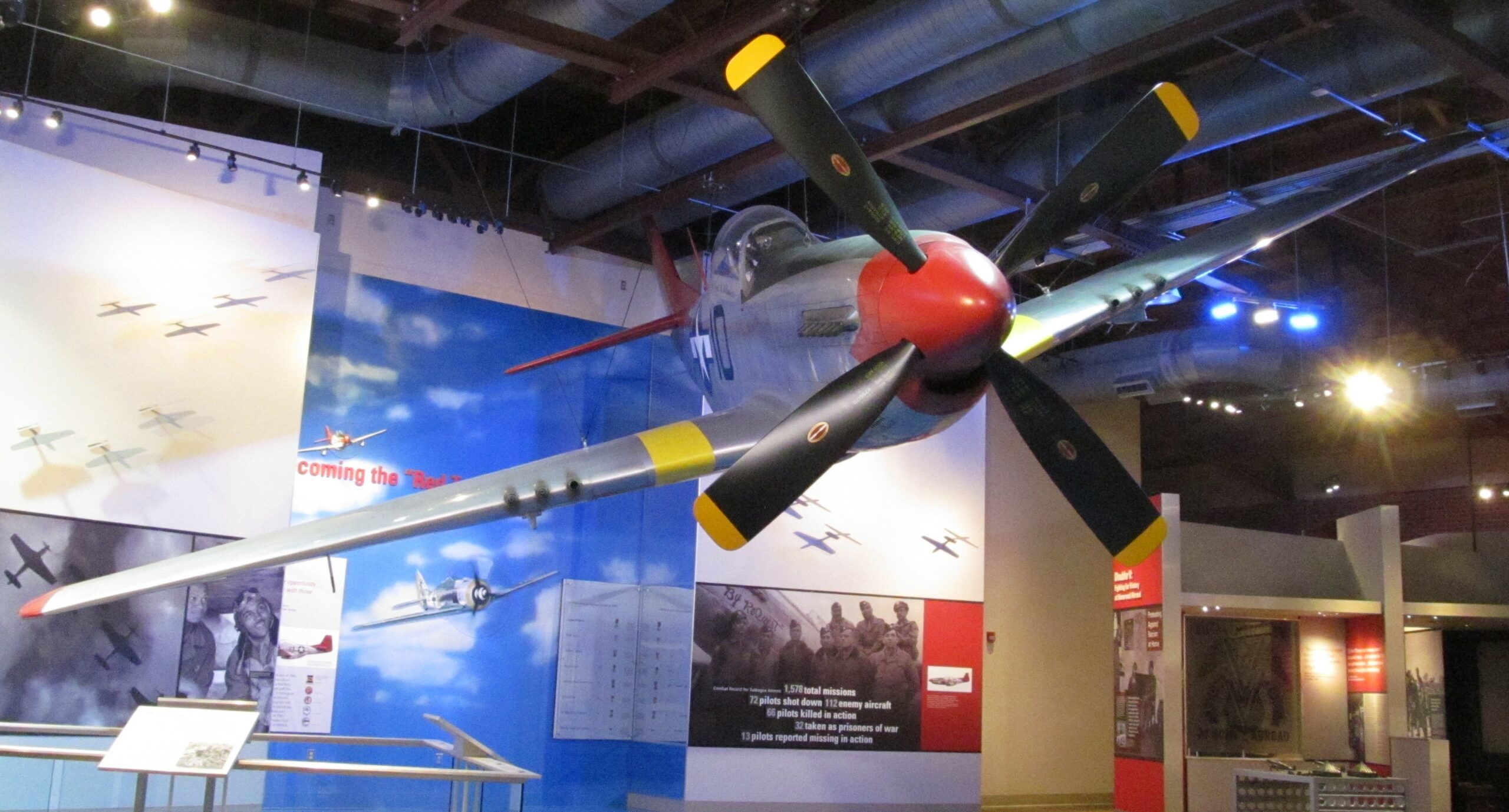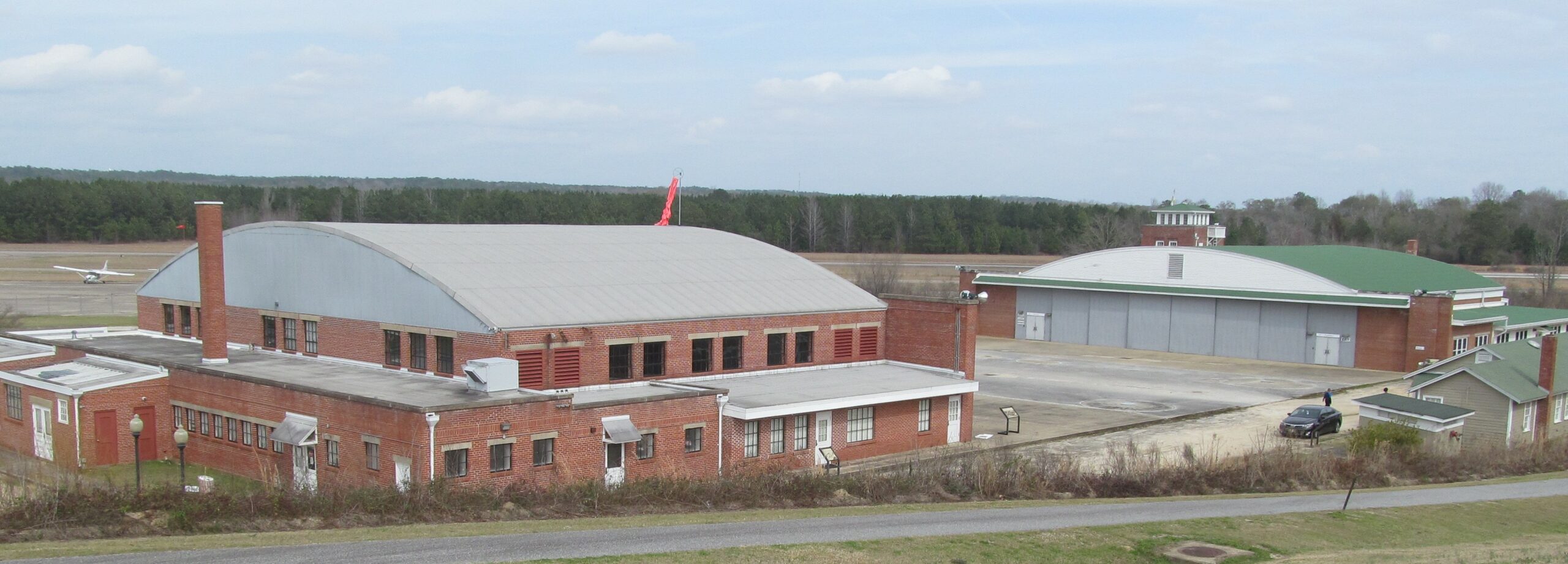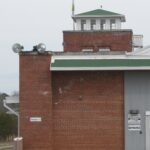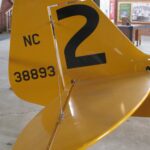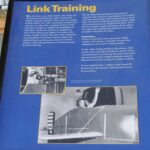by Marty Steiner
Most aviation enthusiasts will have learned at least some part of the Tuskegee Airmen’s history, but far fewer will know it in depth, nor will they have had the opportunity to visit any of the locations where the legendary group of WWII African American aviators learned to fly.
Vintage Aviation News recently visited Moton Field in Tuskegee, Alabama, the old U.S. Army Air Forces base where the Tuskegee Airmen first trained. Now a National Historic Site under the National Park Service’s creative and watchful management, the aerodrome’s two original hangars house artifacts and exhibits which literally ‘speak for themselves’.
The U.S. Army Air Forces and their successor, the U.S. Air Force, typically name their bases after military pilots or others associated with aviation, especially military aviation. But Moton Field is different. It gained its name from Robert Russa Moton, the former head of the nearby Tuskegee Institute. Moton became the organization’s President in 1915 following the death of it’s founder, the renowned Booker T. Washington. Despite his affiliation with the airfield, Moton was not an aviator of any sort.
Moton Field was still incomplete when the first group of 13 African-American cadets were due to begin their flight training, so the Tuskegee Institute arranged for these students to begin taking their first steps skywards at nearby Kennedy Field, a small grass strip with a small fleet of Piper Cubs on hand. Now long-abandoned, Kennedy Field had a moment under the spotlight on March 29th, 1941 when Eleanor Roosevelt, then the First Lady, received a demonstration flight in one of the Cubs with the resident instructor, Charles Anderson, at the controls. At the time, most knew Anderson simply as “Chief” due to his role as Chief Flight Instructor. Roosevelt’s flight with “Chief” led to her active support for African Americans becoming pilots in the U.S. military, culminating in the establishment of the 99th Pursuit Squadron in January of 1941. The 99th became the first segregated U.S. air combat unit.
Present day visitors will typically proceed through the “official” entrance to the site from an overlook parking area, which provides a great overview of the entire installation. The long, downhill path has excellent signage along the way, helping people gain insight into the base’s history and for the men who trained there. However, for those who might find that path too taxing physically, especially on the uphill return, Vintage Aviation News suggests using the Moton Field entrance, which provides a route to drive down to the historic area. This entrance is marked by a large “Moton Field Municipal Airport” sign.
The entry into Hangar 1 provides a ranger reception desk with information folders. The route through this hangar will lead visitors past a number of focused exhibits and an exit to Hangar 2. Hangar 1 includes two, beautifully restored examples of training aircraft which the Tuskegee cadets once flew: a Piper C-2 Cub and Boeing PT-17 Kaydet. Hangar 2, with its attached control tower, provides additional displays below a full-scale replica of a P-51 Mustang.
The museum features a considerable emphasis describing the roots of what became the “Double V” movement, an early civil rights action. Its exhibits are both well thought out and presented. A “walk-through” of the two hangars will provide a visitor with information available only in a few books on the Tuskegee Airmen. The size disparity between this base and its typical, far larger contemporaries is striking for anyone familiar with such facilities.
Many museums offer modern audio aids to visitors, but this site features era-appropriate, vintage dial telephones through which one can listen to oral histories. It is a cool concept, almost like picking up the phone on a 1940’s ‘party line’ to listen in on your neighbor’s conversation, but in this case you hear actual participants recounting personal experiences about the Tuskegee Airmen. These recordings are excerpts from the extensive National Park Service Tuskegee Airmen Oral History Project. Both the site’s planning and the oral history recordings date back to 1998, when many more participants were available for interview. Visitors can also peer into an airman’s locker and see authentic uniforms hung neatly in place.
A visitor’s information folder presents the early history of the 1939 Civilian Pilot Training Act (CPT) and the designation of six black colleges among the list of CPT training sites; Tuskegee Institute being one of these six. Eventually, three training fields were established in the area; Kennedy Field for Pre-flight, Moton Field for Primary, and Tuskegee Army Air Field for Basic and Advanced training. Today only Moton is open and available for the public to visit.
The exhibits in Hangar 1 also take the visitor through a timeline leading from the cadets arrival at Moton, through a description of the bases, to portraying the various base support functions (so often ignored). The latter includes the numerous instructional roles, base management, record keeping, morale building and of course the supply staff too. Photographs and brief biographies of the individuals who performed these various functions introduce the voices which visitors can hear via the desk phones nearby.
The Hangar 2 exhibits also include the post-war efforts by the Airmen and their supporters for equality upon their return from war. This effort, known as the “Double V…Fighting for Victory at home and Abroad” was an early civil rights movement. These exhibits conclude with more recent recognition of the many accomplishments of the men who trained at Tuskegee and their impact upon civil liberties. On March 29th, 2007 President George W. Bush presented the Congressional Gold Medal, the nation’s highest civilian award, to the Tuskegee Airmen to recognize “their unique military record that inspired revolutionary reform in the Armed Forces.”
When visiting any historic site, it is best to verify its days and hours of operation beforehand. One can do so for Moton by clicking HERE; at the time of our visit, the site was open between Wednesday and Saturday from 9:00AM (CDT) through 4:30PM. At all other times, the two hangars and the displays within are shut, with only the building exteriors being available for viewing.
Moton Field is easy to find, being roughly 30 miles west of Columbus, Georgia and 38 miles east of Montgomery, Alabama. It lies only one mile south of Exit 38 on Interstate I-85, where you will follow Alabama Highway 81 south to Chappie James Rd (left turn). The first sign and entrance you see are for Moton Field Municipal Airport (which takes you to the FBO); the Historic Site overlook and parking follows shortly after. Both entrances are on the left. The Site phone number is 334.724.0922, for more information, visit www.nps.gov.







